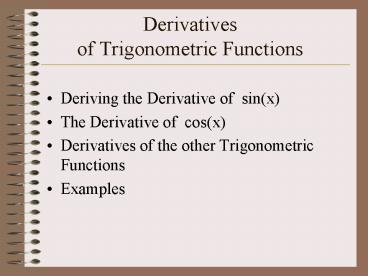Derivatives of Trigonometric Functions PowerPoint PPT Presentation
Title: Derivatives of Trigonometric Functions
1
Derivatives of Trigonometric Functions
- Deriving the Derivative of sin(x)
- The Derivative of cos(x)
- Derivatives of the other Trigonometric Functions
- Examples
2
The Derivative of sin x
- To find the derivative of sin x, we need to
recall two limits we discovered in lab.
and
3
Using these limit results, we can use the
definition of the derivative to find derivatives
of sin x and cos x.
4
Using similar techniques we can show that if y
cos x, then y - sin x.
Using the formulas derived for sin x and cos x,
we can use the quotient rule to find the
derivatives of the other 4 trigonometric
functions
5
So, we have
You should be able to derive the derivatives of
the final three trigonometric functions
6
Find the 93rd derivative of sin x
- f (x) cos x
- f (x) - sin x
- f (x) - cos x
- f iv (x) sin x
- f v (x) cos x
- So, f (93) (x) f (f (92) (x)) f (sin
x) - cos x
7
Example
For what values of x does the function above
have a horizontal tangent line?
Where do horizontal tangentlines occur on the
graph of afunction ?
At local max/min points. (humps)
Local max/min points generally occur where the
derivative is equal to zero.
So we need to find the x-values that make the
derivative equal to zero.
8
Example(contd)
9
Example(contd)
So, now we have
Now if f (x) is to be zero, either sec x or
tan x 1 must equal zero.
Recall the graph of sec x ?
You should note that secant is never zero.
10
Example(contd)
And sec x ? 0, sotan x 1 must 0
We have
So, tan x 1. What values of x make this
true?
tan x ?
tan x 1 when x n? ?/4
11
Verifying Results
This is the graph of the original function
Note how the horizontal tangent lines occur at
multiples of ?/4.
PowerShow.com is a leading presentation sharing website. It has millions of presentations already uploaded and available with 1,000s more being uploaded by its users every day. Whatever your area of interest, here you’ll be able to find and view presentations you’ll love and possibly download. And, best of all, it is completely free and easy to use.
You might even have a presentation you’d like to share with others. If so, just upload it to PowerShow.com. We’ll convert it to an HTML5 slideshow that includes all the media types you’ve already added: audio, video, music, pictures, animations and transition effects. Then you can share it with your target audience as well as PowerShow.com’s millions of monthly visitors. And, again, it’s all free.
About the Developers
PowerShow.com is brought to you by CrystalGraphics, the award-winning developer and market-leading publisher of rich-media enhancement products for presentations. Our product offerings include millions of PowerPoint templates, diagrams, animated 3D characters and more.

